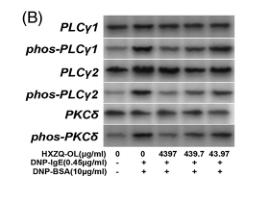PLCG2 Antibody - #AF7738
| Product: | PLCG2 Antibody |
| Catalog: | AF7738 |
| Description: | Rabbit polyclonal antibody to PLCG2 |
| Application: | WB |
| Cited expt.: | WB |
| Reactivity: | Human, Mouse, Rat |
| Prediction: | Pig, Bovine, Horse, Sheep, Rabbit, Dog |
| Mol.Wt.: | 150kDa; 148kD(Calculated). |
| Uniprot: | P16885 |
| RRID: | AB_2844102 |
Related Downloads
Protocols
Product Info
*The optimal dilutions should be determined by the end user. For optimal experimental results, antibody reuse is not recommended.
*Tips:
WB: For western blot detection of denatured protein samples. IHC: For immunohistochemical detection of paraffin sections (IHC-p) or frozen sections (IHC-f) of tissue samples. IF/ICC: For immunofluorescence detection of cell samples. ELISA(peptide): For ELISA detection of antigenic peptide.
Cite Format: Affinity Biosciences Cat# AF7738, RRID:AB_2844102.
Fold/Unfold
1 phosphatidylinositol 4 5 bisphosphate phosphodiesterase gamma 2; 1-phosphatidylinositol-4; 5-bisphosphate phosphodiesterase gamma-2; EC 3.1.4.11; Phosphoinositide phospholipase C; Phosphoinositide phospholipase C-gamma-2; Phospholipase C gamma 2; Phospholipase C, gamma 2 (phosphatidylinositol specific); Phospholipase C-gamma-2; Phospholipase C-IV; PLC 2; PLC gamma 2; PLC IV; PLC-gamma-2; PLC-IV; Plcg2; PLCG2_HUMAN;
Immunogens
A synthesized peptide derived from human PLCG2, corresponding to a region within C-terminal amino acids.
- P16885 PLCG2_HUMAN:
- Protein BLAST With
- NCBI/
- ExPASy/
- Uniprot
MSTTVNVDSLAEYEKSQIKRALELGTVMTVFSFRKSTPERRTVQVIMETRQVAWSKTADKIEGFLDIMEIKEIRPGKNSKDFERAKAVRQKEDCCFTILYGTQFVLSTLSLAADSKEDAVNWLSGLKILHQEAMNASTPTIIESWLRKQIYSVDQTRRNSISLRELKTILPLINFKVSSAKFLKDKFVEIGAHKDELSFEQFHLFYKKLMFEQQKSILDEFKKDSSVFILGNTDRPDASAVYLHDFQRFLIHEQQEHWAQDLNKVRERMTKFIDDTMRETAEPFLFVDEFLTYLFSRENSIWDEKYDAVDMQDMNNPLSHYWISSSHNTYLTGDQLRSESSPEAYIRCLRMGCRCIELDCWDGPDGKPVIYHGWTRTTKIKFDDVVQAIKDHAFVTSSFPVILSIEEHCSVEQQRHMAKAFKEVFGDLLLTKPTEASADQLPSPSQLREKIIIKHKKLGPRGDVDVNMEDKKDEHKQQGELYMWDSIDQKWTRHYCAIADAKLSFSDDIEQTMEEEVPQDIPPTELHFGEKWFHKKVEKRTSAEKLLQEYCMETGGKDGTFLVRESETFPNDYTLSFWRSGRVQHCRIRSTMEGGTLKYYLTDNLTFSSIYALIQHYRETHLRCAEFELRLTDPVPNPNPHESKPWYYDSLSRGEAEDMLMRIPRDGAFLIRKREGSDSYAITFRARGKVKHCRINRDGRHFVLGTSAYFESLVELVSYYEKHSLYRKMRLRYPVTPELLERYNMERDINSLYDVSRMYVDPSEINPSMPQRTVKALYDYKAKRSDELSFCRGALIHNVSKEPGGWWKGDYGTRIQQYFPSNYVEDISTADFEELEKQIIEDNPLGSLCRGILDLNTYNVVKAPQGKNQKSFVFILEPKQQGDPPVEFATDRVEELFEWFQSIREITWKIDTKENNMKYWEKNQSIAIELSDLVVYCKPTSKTKDNLENPDFREIRSFVETKADSIIRQKPVDLLKYNQKGLTRVYPKGQRVDSSNYDPFRLWLCGSQMVALNFQTADKYMQMNHALFSLNGRTGYVLQPESMRTEKYDPMPPESQRKILMTLTVKVLGARHLPKLGRSIACPFVEVEICGAEYDNNKFKTTVVNDNGLSPIWAPTQEKVTFEIYDPNLAFLRFVVYEEDMFSDPNFLAHATYPIKAVKSGFRSVPLKNGYSEDIELASLLVFCEMRPVLESEEELYSSCRQLRRRQEELNNQLFLYDTHQNLRNANRDALVKEFSVNENQLQLYQEKCNKRLREKRVSNSKFYS
Predictions
Score>80(red) has high confidence and is suggested to be used for WB detection. *The prediction model is mainly based on the alignment of immunogen sequences, the results are for reference only, not as the basis of quality assurance.
High(score>80) Medium(80>score>50) Low(score<50) No confidence
Research Backgrounds
The production of the second messenger molecules diacylglycerol (DAG) and inositol 1,4,5-trisphosphate (IP3) is mediated by activated phosphatidylinositol-specific phospholipase C enzymes. It is a crucial enzyme in transmembrane signaling.
Phosphorylated on tyrosine residues by CSF1R (By similarity). Phosphorylated on tyrosine residues by BTK and SYK; upon ligand-induced activation of a variety of growth factor receptors and immune system receptors. Phosphorylation leads to increased phospholipase activity.
Research Fields
· Environmental Information Processing > Signal transduction > ErbB signaling pathway. (View pathway)
· Environmental Information Processing > Signal transduction > Ras signaling pathway. (View pathway)
· Environmental Information Processing > Signal transduction > Calcium signaling pathway. (View pathway)
· Environmental Information Processing > Signal transduction > NF-kappa B signaling pathway. (View pathway)
· Environmental Information Processing > Signal transduction > HIF-1 signaling pathway. (View pathway)
· Environmental Information Processing > Signal transduction > Phosphatidylinositol signaling system.
· Environmental Information Processing > Signal transduction > Phospholipase D signaling pathway. (View pathway)
· Human Diseases > Drug resistance: Antineoplastic > EGFR tyrosine kinase inhibitor resistance.
· Human Diseases > Infectious diseases: Bacterial > Vibrio cholerae infection.
· Human Diseases > Infectious diseases: Bacterial > Epithelial cell signaling in Helicobacter pylori infection.
· Human Diseases > Infectious diseases: Viral > Epstein-Barr virus infection.
· Human Diseases > Cancers: Overview > Pathways in cancer. (View pathway)
· Human Diseases > Cancers: Overview > Proteoglycans in cancer.
· Human Diseases > Cancers: Overview > MicroRNAs in cancer.
· Human Diseases > Cancers: Specific types > Glioma. (View pathway)
· Human Diseases > Cancers: Specific types > Non-small cell lung cancer. (View pathway)
· Human Diseases > Cancers: Specific types > Hepatocellular carcinoma. (View pathway)
· Metabolism > Carbohydrate metabolism > Inositol phosphate metabolism.
· Metabolism > Global and overview maps > Metabolic pathways.
· Organismal Systems > Development > Axon guidance. (View pathway)
· Organismal Systems > Development > Osteoclast differentiation. (View pathway)
· Organismal Systems > Immune system > Platelet activation. (View pathway)
· Organismal Systems > Immune system > Natural killer cell mediated cytotoxicity. (View pathway)
· Organismal Systems > Immune system > B cell receptor signaling pathway. (View pathway)
· Organismal Systems > Immune system > Fc epsilon RI signaling pathway. (View pathway)
· Organismal Systems > Immune system > Fc gamma R-mediated phagocytosis. (View pathway)
· Organismal Systems > Immune system > Leukocyte transendothelial migration. (View pathway)
· Organismal Systems > Nervous system > Neurotrophin signaling pathway. (View pathway)
· Organismal Systems > Sensory system > Inflammatory mediator regulation of TRP channels. (View pathway)
· Organismal Systems > Endocrine system > Thyroid hormone signaling pathway. (View pathway)
References
Application: WB Species: Mouse Sample: RBL-2H3 cells
Restrictive clause
Affinity Biosciences tests all products strictly. Citations are provided as a resource for additional applications that have not been validated by Affinity Biosciences. Please choose the appropriate format for each application and consult Materials and Methods sections for additional details about the use of any product in these publications.
For Research Use Only.
Not for use in diagnostic or therapeutic procedures. Not for resale. Not for distribution without written consent. Affinity Biosciences will not be held responsible for patent infringement or other violations that may occur with the use of our products. Affinity Biosciences, Affinity Biosciences Logo and all other trademarks are the property of Affinity Biosciences LTD.
